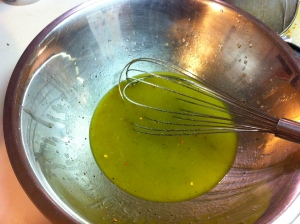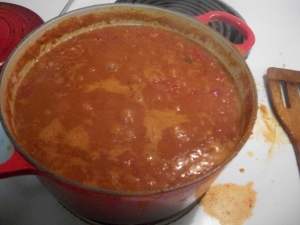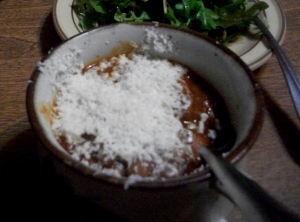
My mother-in-law recently gave me Seven Fires, an encomium to grilling over live fire by the Argentine chef, Francis Mallmann. Seven Fires passes the crucial test of any cookbook: It makes me want to cook. Particularly, this book makes me want to cook an entire cow over a bonfire by a secluded lake in Patagonia, but, barring that, it makes me want to grill anything, anywhere.
So, the recent World Cup match between Argentina and Germany seemed like the perfect pretext for starting a fire at 7:00 AM and testing Mallmann’s infectiously presented philosophy that everything tastes better when grilled.

Since we don’t happen to own a grill (or a TV, for that matter), and since we are already in the habit of exploiting the generosity of our good friends, The Bearded Quaker and Nurse Lanois, we decided to host the game at their place. They seemed a little taken aback when I showed up at their house the night before for the pre-game slumber party armed with clarified butter, crêpe batter and a dozen sausages, but, good friends that they are, they have learned to roll with my various eccentricities.
I figured that if I could grill panqueques, savory crêpes to be filled with dulce de leche, I could grill anything. While I was out there, I might as well throw some sausages on the fire; there was no Argentine chorizo to be found, but some German bratwurst seemed like a noble and diplomatic concession to the opponent. (My Lovely Vegetarian Wife is also of Polish heritage, so some kielbasa had to find its way on to the menu as well. She would have been bitterly disappointed without it, I am sure.) To round out this menu, I had been dying to try Mallmann’s recipe for burnt oranges with rosemary, a dish that he strongly urged should only be prepared outside due to the prodigious amounts of smoke it was sure to create.

Cooking, like all crafts, can be an act of self-discovery when it calls upon our resources and ingenuity to their fullest extent. There were many uncertainties about my plans for an asado para desayuno (including whether my in-laws would disown me for coining absurd Spanish phrases like that): Would I be able to fire up a grill at 6:30 in the morning? For that matter, could I even wake up at 6:30 in the morning on a Saturday? Would I be able to adjust the coals sufficiently under a cast-iron skillet to control its heat? Could I do this while also grilling sausages? And would anybody else be awake to make me a cup of coffee??

The answer to all of those questions was “Yes”. The crêpes cooked almost instantly and got gorgeous crispy edges; the oranges were sweet, jammy, nicely charred and herbal from the rosemary; the sausage was sausage (i.e., the single greatest food known to humanity).
The game, alas, did not go nearly as well as the breakfast. According to my wife, we have banished this game from our collective memory. It is not to be spoken of.

We drowned our sorrows with mimosas.

Panqueques con Dulce de Leche
serves a dozen hungry soccer fans
- 1 1/2 c butter (Don’t worry—you’re not going to eat all of it.)
- 3 c flour
- 8 eggs
- 2 c water
- 2 c milk
Make the panqueque batter and the clarified butter the night before, or at least 1 hour in advance: Melt all of the butter in a heavy saucepan over low heat. Combine 1/2 c of the melted butter, the flour, eggs, water, milk and a hefty pinch of salt in a blender; blend on high speed until thoroughly mixed. Refrigerate.
Finish clarifying the butter: Skim off and discard any foam from the top of the butter. Carefully pour off and reserve the melted butterfat, leaving the milk solids in the bottom of the pan behind. Discard the milk solids. Refrigerate the clarified butter; it will solidify in the fridge. If you want to melt it before using it, simply microwave for about 20 seconds.
Using charcoal (or, even better, hardwood), build a hot fire. Pile the coals to one side of the grill so that they reach up almost all the way to the grill rack. Place a flat cast-iron griddle on the grill rack directly over the coals. Cover the grill and allow the griddle to preheat for about 10 minutes. (Alternately, simply heat up the griddle indoors over medium-high heat.) When a drop of water evaporates instantly on the griddle, it is ready.
Stir up the pancake batter in case it has separated. Put a tablespoon of the clarified butter on the griddle, spreading it around to coat the griddle evenly. Ladle about 1/4 c of the batter onto the griddle, spreading it around with the ladle to form a thin layer over the whole griddle. The panqueque will cook very quickly: When the edges are brown and firm, flip the crêpe. Cook for about 15 seconds more on the second side until the pancake is cooked through.
Transfer to a plate. Put a heaping spoonful of dulce de leche on the panqueque and spread it around. Roll up the pancake like a jelly roll. Repeat with the remaining panqueques, adding more clarified butter to the griddle before each one. Serve with…
Naranjas Quemadas con Romero (Burnt Oranges with Rosemary)
- 6 oranges
- 1 c sugar
- 1 sprig of rosemary
Preheat a cast-iron griddle for ten minutes over a hot wood or charcoal fire (or, if you have a stove with a powerful exhaust fan, heat the skillet over high heat). Meanwhile, peel the oranges and slice them in half through their “equator”. Place the sugar on a plate. Strip the rosemary leaves from the sprig and add them to the sugar. Press the oranges, cut side down, into the sugar.
When the griddle is hot (a drop of water will evaporate instantly), put four of the orange halves, cut side down, onto the griddle. Add a little more of the rosemary-sugar mixture to the griddle between the oranges. Cook the oranges over high heat without moving them until the edges brown and start to blacken. Carefully flip the oranges and cook on the second side for 1-2 minutes more. Serve along side panqueques con dulce de leche and grilled sausages for brunch, or with a little sweetened yogurt for dessert.

Read Full Post »





























